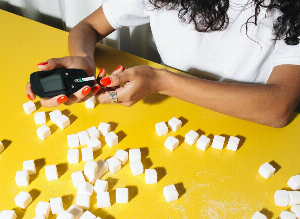Treatments for Type 2 diabetes: What do patients think?
Published May 13, 2021 • By Clémence Arnaud
Type 2 diabetes is much more prevalent than type 1 diabetes and can lead to other conditions when not properly controlled, such as high blood pressure, vascular complications and kidney disease. Different treatments are available to control blood sugar levels in patients with type 2 diabetes.
What are the treatment strategies for type 2 diabetes? What do patients think about their treatments?
We tell you all about it in our article!

There are many treatments available for people living with type 2 diabetes. These medications are prescribed when lifestyle and dietary measures have been inadequate for controlling blood sugar. The treatments currently available are taken orally or through injection.
Oral antidiabetic drugs
Drugs that improve insulin sensitivity
These medications improve the effectiveness of insulin in the liver and muscles in particular. The class of treatment used is the biguanides with metformin as the only molecule.
When it is not sufficient enough to control blood sugar, metformin can be used in combination with medications which stimulate insulin production (hypoglycemic sulfamides, glinides) or with insulin.
![]()
A patient from the Carenity France platform wrote about the French metformin brand Stagid®: "Apart from a few digestive problems from time to time, it's a good treatment."
![]()
With regard to metformin, a member in the UK described: "...It does affect the stomach but with the addition stomach remedies, the problem was resolved."
>> Feel free to read our article about metformin here <<
Drugs that stimulate insulin production
Two classes of antidiabetic medication stimulate the release of a greater quantity of insulin by the pancreas: hypoglycemic sulfamides (glibenclamide, gliclazide…) and prandial glucose regulators, or glinides (repaglinide).
The hypoglycemic sulfamides are often offered in combination with metformin.
Glinides have an action time which is slightly less than hypoglycemic sulfamides and must be taken right before the meal.
![]()
As with other antidiabetic medicines, the issue raised in patients taking this treatment is hypoglycemia.
Such is the case for this patient from the Carenity France platform: "Having several oral medications to take each day and one injection per week, I don't know to what extent gliclazide acts in improving blood sugar. For now, only this cocktail is proving to have an effect on results if I pay attention to my diet and if I do enough walking.”
![]()
A member of Carenity UK also noted: "As the metformin effect diminishes, this drug gives a boost to lowering your blood sugars before the dreaded needle."
Drugs that reduce the absorption of sugars
This is a class of alpha-glucosidase inhibitors that includes acarbose. They delay the digestion process, which results in a slower passage of sugars into the bloodstream after meals. Because of the mechanism of action, they should be taken at the beginning of meals.
They are normally used in combination with other antidiabetic drugs, but can be used alone in case of contraindication or intolerance of metformin and sulfonylureas.
The main undesired and very frequent side effects are digestive in nature with flatulence, diarrhea, etc.
Drugs that act through incretins
Incretins are two intestinal hormones: GLP-1 (glucagon like peptide-1) and GIP (glucose-dependent insulinotropic polypeptide). They are secreted after a meal and control insulin secretion by the pancreas. Glucagon secretion is also limited.
Two classes of drugs exist, gliptins are a class of molecules that are taken orally. They inhibit the action of dipeptidylpeptidase-4 and therefore slow down the degradation of GLP-1 (Januvia®).
The risk of hypoglycemia with gliptins is reduced because they only act when the blood sugar level is raised.
Drugs that help to remove sugars
Dapagliflozin belongs to a class of antidiabetic drugs called sodium-glucose cotransporter type 2 (SGLT2) inhibitors. SGLT2 is present in the kidneys. These antidiabetic drugs block its action, decreasing the reabsorption of glucose in the kidneys and, as a result, increase the elimination of glucose in the urine.
Oral antidiabetic drug combinations
Controlling blood sugar sometimes requires the combination of two anti-diabetic drugs which belong to classes that have different modes of action. There are fixed combinations of antidiabetic drugs that allow you to only take one tablet: metformin and sulfonylurea (Glucovance®), and metformin and a dipeptidylpeptidase-4 inhibitor (gliptin) (Janumet®).
![]()
With regard to Janumet®, a Carenity France member commented: "Satisfied by it overall but I have a reservation, because at time I have diarrhea which could be caused by Janumet."
Injectable antidiabetic drugs
Drugs that act through incretins
As we have already discussed, some molecules act on blood sugar levels via incretins. This is the case for glucagon-like peptide analogues and substances close to glucagon like peptide-1 (GLP-1), which resist the action of dipeptidylpeptidase (Trulicity®, Ozempic®, Victoza®, etc.)
A member of Carenity France platform shared about Trulicity®: "It's very good. For me, I had almost all the side effects, but I have acquaintances who had nothing, I persevered because I lost 11 kilos and my hemoglobin went from 8.8 to 6.7. An injection once a week done by myself."
![]()
A Carenity UK member also shared: "...Very easy, no separate needles. Each injection comes complete - inject then dispose. Too early to tell how effective it is but the research says more effective than Byetta. Life is much easier."
Insulin injections
Insulin is a molecule that is mainly used in type 1 diabetes. However, it can be used in type 2 diabetes when the diabetes is not well controlled.
>>> Don't hesitate to read our article on flexible insulin therapy here <<<
Injectable antidiabetic drug combinations
A drug combining a long-acting insulin (insulin degludec) and an injectable antidiabetic (liraglutide, a glucagon-like peptide analogue) is now available. It is called Xultophy®. It is used in the treatment of type 2 diabetes, in combination with other oral antidiabetic drugs, when these drugs, together with diet and exercise, have been shown to be insufficient to control diabetes.
"If you are careful with each meal it is a very effective insulin," commented a member of the French platform.
Please consult your health care professional first if you have any questions about your treatment.
Was this article helpful to you?
Are you taking any treatments for diabetes?
Share your experience and your questions about your treatments with the community in the comments below!
Take care!
Comments
You will also like

Diabetes: Discrimination, Professional Life, Plan Ahead... What do patients say?
Nov 9, 2018 • 9 comments

 Facebook
Facebook Twitter
Twitter

